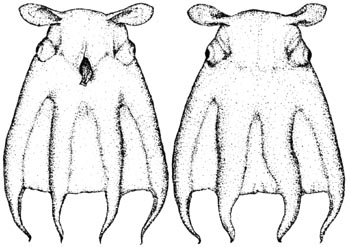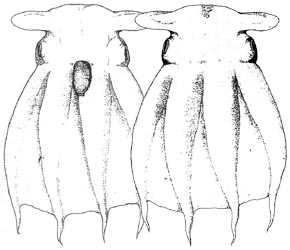Opisthoteuthis massyae
Roger Villanueva, Michael Vecchione, and Richard E. YoungIntroduction
O. massyae is known only from the Eastern Atlanic. It is unusual in having especially thick arms I in males.
Characteristics
- Arms and web
 image info
image info Figure. Oral view of O. massyae, mature male, 75 mm ML. Drawing from Villanueva et al., 2002.
- Arms subequal in length.
- Arms I in males very thick, muscular and robust proximally to level of web margin; arms I normal in females.
- Arm sucker counts 82-106 (males) or 85-87 (females).
- Web sectors approximately equal.
- Males with two fields of enlarged suckers present; largest sucker diameter of distal field less than that of proximal field.
- Proximal field with typically 7-8 suckers enlarged and occupying positions between suckers 2 and 13; sucker 7 usually largest; all arms with equal enlargement.
- Distal field with usually 9-11 suckers enlarged, typically beginning with sucker numbers 34-40; suckers 40-41 usually largest; distal enlargement absent on arms I, moderate on arms II and maximal on arms III and IV.
- Cirri short; longest 2.0-6.4 mm or 7.8% of ML in mature males.
- First cirri appear between suckers 3 and 5.
- Web nodules
- Multiple web nodules (= web supports) present on ventral margin of each arm; proximal support stout, subsequent ones weak; supports number 7-20 per arm (ave. 14); supports typically begin at level of sucker 35-37, approximately the first distal enlarged sucker in males.
 image info
image info Figure. Oral view of the end of arm III of O. massyae showing web nodules. Arrows point to two nodules. Drawing from Villanueva et al. (2002).
- Multiple web nodules (= web supports) present on ventral margin of each arm; proximal support stout, subsequent ones weak; supports number 7-20 per arm (ave. 14); supports typically begin at level of sucker 35-37, approximately the first distal enlarged sucker in males.
Comments
More details of the description of O. massyae can be found here.
O. massyae differs from all members of the genus (where males are known) in having especially broad arms I in mature males. Also unuaual are enlarged suckers in the distal field on arms II-III, a feature that it shares only with O. pluto.
Nomenclature
This species was originally described as Cirroteuthis umbellata by Massy in 1909. Grimpe (1920) recognized that it was a new species and named it Cirroteuthopsis massyae. Villanueva et al. (2002) placed it in the genus Opisthoteuthis. Opisthoteuthis vossi Sanchez and Guerra, 1991, is a junior synonym of O. massyae (Villanueva et al., 2002).
Life History
Males reach a larger size than females; males weigh up to 5750 g and females up to 2959 g (Boyle, et al., 1998). The relationship between total weight and total length is TW = 19x10-5xTL2.7 for both sexes (Villanueva and Guerra, 1991).
Mature eggs are 9-12 mm long, 4.8-5.0 mm wide.
Distribution
Type locality: Off Ireland at 50°31'N, 11°31'W, 1226-1450 m. O. massyae is known only from the Eastern Atlantic from off Ireland to off Namibia and possibly South Africa (Villanueva et al., 2002).
References
Boyle, P. R. and M. A. Collins and G. R. Williamson. 1998. The cephalopod by-catch of deep-water trawling on the Hebrides slope. J. Mar. Biol. Ass. U. K. 78: 1023-1026.
Massay, A. L. (1909). The Cephalopoda Dibranchiata of the coasts of Ireland. Fisheries, Ireland, Scientific Investigations for 1907, 1: 1-39.
Grimpe, G. 1920. Teuthologische Mitteilungen V. Zwei neue Cirraten-Arten. Zoologischer Anzeiger, 51: 230-243.
Sanchez, P. and A. Guerra. 1989. A new species of cirrate octopod Opisthoteuthis vossi from the southeast Atlantic (Cephalopoda: Octopoda). Bull. Mar. Sci., 44: 1159-165.
Villanueva, R., Collins, M., Sanchez, P. and N. Voss. 2002. Systematics, distribution and biology of the cirrate octopods of the genus Opisthoteuthis (Mollusca, Cephalopoda) in the Atlantic Ocean, with description of two new species. Bulletin of Marine Science 71(2):933-985.
Title Illustrations
| Scientific Name | Opisthoteuthis massyae |
|---|---|
| Comments | holotype of Opisthoteuthis "vossi" |
| Reference | Sanchez, P. and A. Guerra. 1989. A new species of cirrate octopod Opisthoteuthis vossi from the southeast Atlantic (Cephalopoda: Octopoda). Bull. Mar. Sci., 44: 1159-165. |
| Sex | Male |
| Size | 55 mm ML |
| Type | Holotype |
| Copyright | © 1989 Bulletin of Marine Science |
| Scientific Name | Opisthotetuhis massyae |
|---|---|
| Reference | Villanueva, R., Collins, M., Sanchez, P. and N. Voss. 2002. Systematics, distribution and biology of the cirrate octopods of the genus Opisthoteuthis (Mollusca, Cephalopoda) in the Atlantic Ocean, with description of two new species. Bulletin of Marine Science 71(2):933-985. |
| Sex | Male |
| Life Cycle Stage | Mature |
| View | Ventral and dorsal |
| Size | 75 mm ML |
| Copyright | © 2002 Bulletin of Marine Science |
About This Page
Instituto de Ciencias del Mar (CSIC)
Paseo Juan de Borbon s/n
E-08039 Barcelona
Spain
National Marine Fisheries Service
Systematics Laboratory
National Museum of Natural History
Washington, D. C. 20560
USA
Richard E. Young
Dept of Oceanography
University of Hawaii
Honolulu, Hawaii 96822
USA
Page copyright © 2003 , , and Richard E. Young
- First online 13 May 2003
Citing this page:
Villanueva, Roger, Vecchione, Michael, and Young, Richard E. 2003. Opisthoteuthis massyae . Version 13 May 2003 (under construction). http://tolweb.org/Opisthoteuthis_massyae/20161/2003.05.13 in The Tree of Life Web Project, http://tolweb.org/










